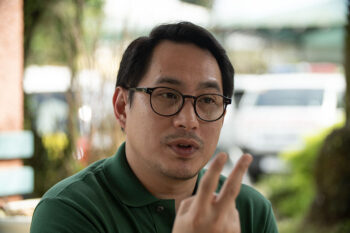III. Closing the Gap
GENERAL SANTOS CITY (MindaNews/15 August) –The “heaven and earth” gap created by the GPH “3 for 1” Proposal boldly stated two realities: Government proclaimed, “This is the autonomy for the Moros we want.” MILF was forthright: “We reject that autonomy.” That is now water under the bridge.
From extremely far apart positions, Government and MILF eventually met midway to seal the Decision Points on Principle and the Framework Agreement on Bangsamoro.
With this closing of the gap, how close is the realization of the Bangsamoro as the political settlement envisioned by MILF to solve the Bangsamoro Problem?
Not so fast! The closing of the gap exposed the chink in Leonen’s “honestly different” negotiation mode. In the negotiation of the Annexes, hard bargaining was and still is the modus operandi of the game. It should be rather asked: How closed now is the gap?
Agreeing
What do the Decision Points and the FAB show?
First: Government has abandoned the “3 for 1” Proposal as its draft proposal but not its view of the Moro Problem and its proposals on how to basically solve it as contained in “3 for 1”. It has stuck to the Leonen “honestly different” approach in negotiation.
Second: While Government also has stuck to its concession that “most of the demands of the MILF for self-governance can be accommodated within the present Constitution”, it has tempered its contention that “the MILF’s proposal for constitutional amendments to allow the creation of a Bangsamoro substate whereby they themselves will craft the Bangsamoro Basic Law is not viable at this time”.
What can be surmised from the Decision Points and the FAB?
To arrive at the Decision Points, the panels culled from the MILF Peace Draft and the GPH “3 for 1” Proposal the points they could agree on and those they significantly, if not contentiously, differed on. They drafted the agreeable points into the ten key points of the Decision Points which they later elaborated in the FAB. Those they differed on – the potentially contentious, especially the Annexes – they set aside for later discussions.
It took eight months to draft the Decision Points and another five months to craft the FAB – framing nine aspects in the entrenchment of Bangsamoro including details of shared powers, rights, territories, resources and other “doables” and “agreeables”.
That was following the Leonen formula. Had the MILF formula been followed, they would have discussed first the contentious issues like those in the Annexes after which the Comprehensive Agreement (CA) would have been tackled. The time to iron out some rough edges and refine the language or text of the concepts, principles and details would have been during their deliberations on the CA.
As stated earlier, that is now water under the bridge. But like a ghost, that will surface in nagging questions should the entrenchment of the Bangsamoro go awry. The fact now is that the Leonen formula has been followed; yet, the peace process has been stuck in the FAB roadmap for eight months now mired in the Annexes.
Murad must be referring to the MILF Peace Draft when — within two weeks after MILF had rejected the GPH “3 in 1” Proposal and a month after he had met the President in Tokyo — he stated, as MindaNews reported, that to fast-track the peace process the two parties would not tackle anymore issues that had been previously agreed on and instead concentrate on unresolved issues. He estimated those issues to be about 30 to 40 percent of what had remained to be negotiated.
The facts in Murad’s statement may be well seen by comparing closely the MILF Draft Agreement 2011, the GPH “3 for 1” Proposal, the Decision Points on Principle and the Framework Agreement on Bangsamoro. This comparison will show that the gap still existing between the Parties is hypothetically as closed as the unclosed gaps of the differences – for now, the contentious issues of the remaining two Annexes.
From the Annexes will be seen how long and what it would take to fully agree on differences. The Technical Working Groups started discussions months before the signing of the FAB last October 15. It must have been for that reason that they were scheduled for signing by the end of December 2012. Yet, the first of the four was signed last February 27; the second, five months after last July 13; the two others, though said to be 90 percent or more done, within the next five months.
The gap must be fully closed before time completely runs out.
Bridge of Confidence
Statements from the Parties indicate that the differences are still serious challenges to their quest of the final agreement. However, they are confident the Bangsamoro will be installed before President Aquino III steps down on June 30, 2016 because they are committed to peace in Mindanao with the full backing of the President and MILF Chair Murad Ebrahim openly known.
There are other factors that strengthen their bridge of confidence:
(1) The Senate President and the Speaker of the House of Representatives have positively responded to the President’s appeal in his Speech of the Nation Address for the Congress to pass the Bangsamoro Basic Law by the end of 2014.
(2) The peace in Mindanao has the support of civil society, business and church leaders.
(3) As shown in extensive consultations, the FAB has tremendous support from Moro groups and communities.
(4) Peace in Mindanao and the development, as well as social reorientation, of Moro communities, before and after the FAB, have support from foreign governments and aids organizations — moral, technical and financial.
These are also compelling reasons for Government and MILF to fulfill their joint commitments to peace.
Divergent Concerns
However, while their bridge of confidence is reassuring, they appear to be taking the challenges divergently. In the wake of the tough negotiation on wealth-sharing, GPH Panel Chair Ferrer and OPAPP Secretary Deles were elated that the Annex had been signed and the peace process could move on to the eventual entrenchment of the Bangsamoro as scheduled in spite of the rough road ahead. While sharing the same elation and optimism, MILF seemed most concerned about the pace of the talks.
In his State of the Nation Address last July 22, the President confidently said: “Peace is also within reach in a region that has long been torn apart by conflict. In October of the previous year, the Framework Agreement on the Bangsamoro was signed. In truth, just nine days have passed since the signing of the second annex of the agreement. We are confident that we will not have to wait long before hearing more good news on the development of the peace process.”
Three paragraphs later, after exhorting all to support the Bangsamoro, he appealed to the Congress: “Once again, I call on Congress: The Transition Commission that will craft the Bangsamoro Basic Law has already been created. Once their task is completed in keeping with the principles of the peace process, I ask you to pass the Bangsamoro Basic Law before the end of 2014. This way, we will have ample time to prepare for the election of a new Bangsamoro government come 2016.”
Last July 25, MILF Chair Murad met in Darapanan a delegation of civil society leaders in Mindanao. MindaNews (July 26, 2013: Murad: MILF’s Central Committee will help fast-track signing of annexes) reported Murad to have said:
(1) On the MILF commitment: “[W]e are (as far as the MILF Central Committee is concerned) always ready for whatever is necessary in the peace process because … we are all fully supportive … we are fully sold out (to) this peace process and everybody is supportive. So we can always do the same and even more than that if necessary, as the situation dictates.”
(2) On the remaining two annexes: “[S]ome think the wealth-sharing annex can serve as guide to the next annexes but there are some views that the next annexes can be ‘more bloody’.”
(3) On the implication of the slow pace of the negotiation: “[A]t this point (the Central Committee is) trying to discuss all possible difficult issues (in relation to the power-sharing annex). We are exploring all other possible means in order to hasten the process because we know that further delaying the process will have a very negative impact on the timeframe we have set for the transition mechanism and once we cannot catch up with the time frame, then it will affect the entire mechanism that would install the Bangsamoro government by 2016.” (Empasis supplied)
The seemingly divergent concerns as reflected from Malacanang and Darapanan are crucial. As the gap still to be closed is moving toward full closure, is there assurance of time necessary to install properly the Bangsamoro that MILF has envisioned to solve the Bangsamoro Problem? (To Be Concluded)
(“Comment” is Mr. Patricio P. Diaz’ column for MindaViews, the opinion section of MindaNews. The Titus Brandsma Media Awards honored Mr. Diaz with a “Lifetime Achievement Award” for his “commitment to education and public information to Mindanawons as Journalist, Educator and Peace Advocate.” You can reach him at patpdiazgsc@yahoo.com.)







